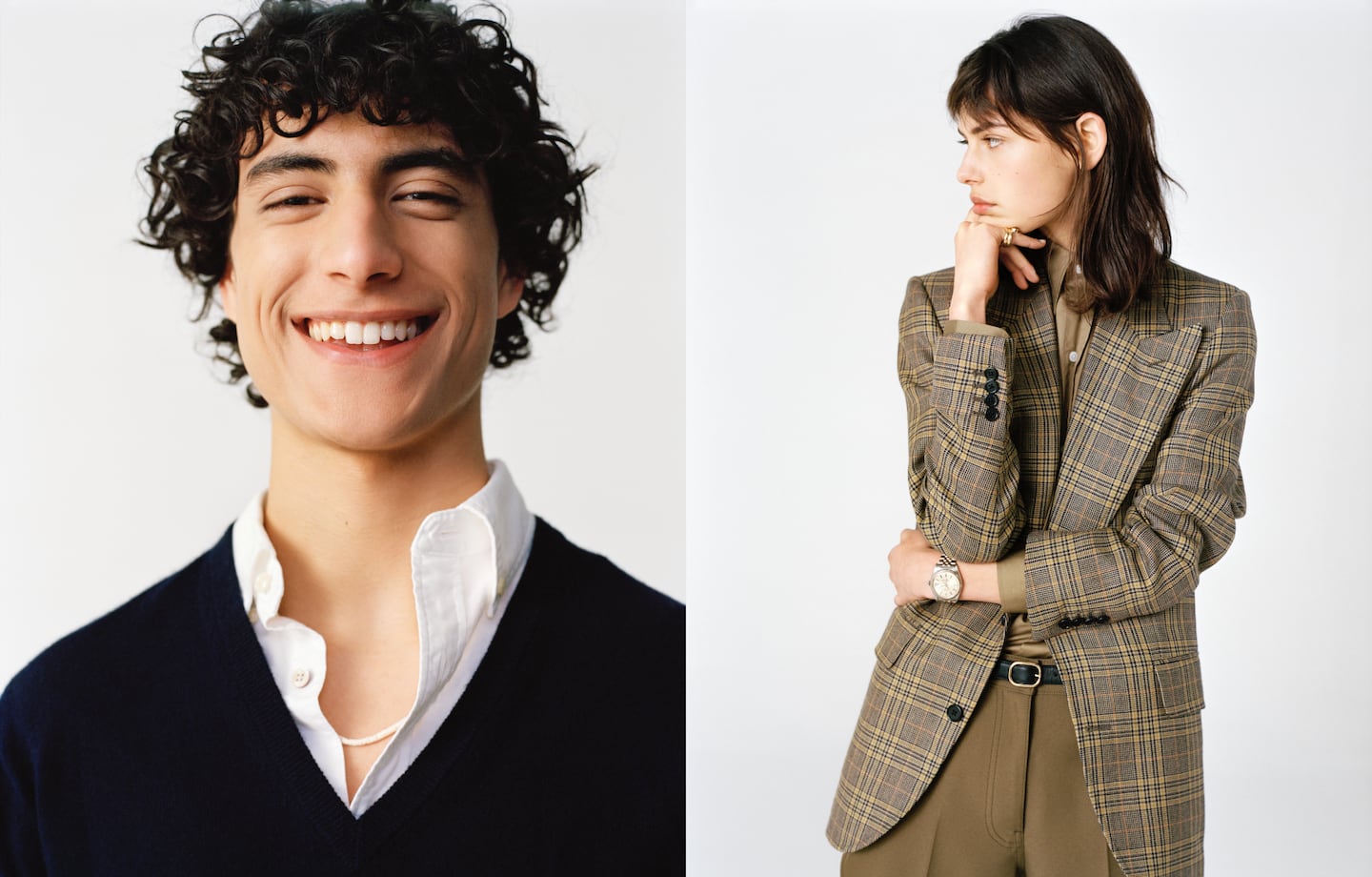
The Business of Fashion
Agenda-setting intelligence, analysis and advice for the global fashion community.

Agenda-setting intelligence, analysis and advice for the global fashion community.

PARIS – Located on a quiet street in Paris’ 16th arrondissement, menswear boutique Beige Habilleur proposes a tight edit of Ring Jacket suits from Japan, Justo Gimeno hunting jackets and Johnstons of Elgin sweaters alongside loafers and derbies from J.M. Weston and Paraboot.
The shop’s founder, Basile Khadiry — who created French menswear review L’Étiquette alongside journalist Marc Beaugé and stylist-designer Gauthier Borsarello in 2018 — has been carrying the torch for understated, classic men’s style for years. (He founded the retailer in 2016 after stints working at luxury retailer Chalhoub Group and Louis Vuitton.)
But in recent months, interest in the previously niche, mostly logo-free aesthetic Khadiry and his associates champion has taken off: L’Étiquette, which is dedicated to demystifying the codes of relaxed French wardrobe dressing, has seen its paid circulation surge to over 50,000 copies per issue over the course of just 10 editions — more than any other men’s magazine in France according to market sources (although rivals publish more frequently). The magazine launched its first-ever women’s edition last month, attracting advertising dollars from Hermès, Rolex and Cartier.
Amid broadening interest, Khadiry is currently renovating a more central space for Beige Habilleur in Paris’ tony 6th arrondissement, with plans to move shop in September.
ADVERTISEMENT
And at French tailoring brand Fursac — where L’Etiquette co-founder Borsarello has been artistic director since 2019 — SMCP’s division operating the label as well as Parisienne womenswear outfit Claudie Pierlot reported first-quarter sales up 22 percent in the first-quarter, on top of 18 percent growth last year. Fursac, which has sought to complement its mid-priced suiting with an elevated, yet laid-back wardrobe signed by Borsarello, recently tapped fashion PR giant Karla Otto to help boost its international visibility and will present its collection on models for the first time during Paris Men’s Fashion Week (which kicks off Tuesday).
The moves are among the latest signs of rising demand for logo-free, understated style, and suggest that the TikTok-fuelled conversation on “quiet luxury” — obsessed with everything from the style of fictional billionaires on HBO’s “Succession” to the cashmere-clad courtroom looks of Gwyneth Paltrow — has legs beyond social media.
While leading purveyors of understated luxury like Loro Piana and Brunello Cucinelli have long enjoyed strong growth, these labels have been outliers in a sector where ultra-visible brands with flashy logos and splashy marketing budgets have squeezed rivals for market share. As the decline of officewear and department stores also pinched more formal brands, a fashion cycle of “logomania”—which blended the codes of streetwear and luxury—has boosted top-tier “clout brands.”
Now, some see fashion becoming a more “subtle game” as the return of dressing up and tailoring seen on the runway in recent seasons continues to gather pace in the real world.
“A lot of people no longer feel the need to distinguish themselves with a logo to show what tribe they belong to. They’re ready to love clothes for other reasons: the quality, the style,” Khadiry said.
Of course, logomania remains a major force in the fashion market, particularly for luxury brands that have spent years marketing lifestyles and identities represented by their marks. In Asia, orders for logo products were up by 8 percent so far this year, according to fashion wholesale platform Joor. But in North America retailers purchased 43 percent fewer logo products, Joor said. Sales of logo-ed items were down 16 percent in EMEA, too.

The shifting winds offer a glimmer of hope for smaller heritage houses which have struggled to keep up with luxury’s dominant megabrands. On the Paris street, low-key, grandpa-coded French footwear classics like Paraboot or Weston are increasingly hard to miss. Those brands have escaped the fatigue some customers feel regarding the social-media saturation of big luxury houses, as well as tending to offer more accessible price points than giants that have hiked prices repeatedly since the pandemic. But even top-end menswear house Zegna — where silk polos and cashmere overshirts are many, while logos are few — cited a “very exciting start to 2023″ on top of better-than-expected sales in 2022.
At the Pitti Uomo trade show this week, relaxed everyday tailoring from logo-free Brunello Cucinelli was a highlight — if hardly a surprise. But even in the outdoor gear segment, whose bold colours and big logos drove interest among streetwear clients in recent years as part of the “gorpcore” aesthetic, the minimalist approaches of Snow Peak and Goldwin caught more buzz than logo-heavy options. Some outdoor brands even pushed into tailoring, with elevated looks including ultra-lightweight technical suiting.
ADVERTISEMENT
The designer segment, where social media storytelling and branding has become as central to many labels’ model as the products themselves, could also be headed for a shakeup. At the LVMH Prize, previous editions helped boost luxury streetwear pioneers like Off-White, branding whizzes like Marine Serre or deft fashion storyteller Jacquemus—all of whom have leaned heavily into logos or monogram. This year, however, finalists identified as fashion’s most promising emerging voices by a jury including Delphine Arnault, Maria Grazia Chiuri and Marc Jacobs showcased off a more sober, product-focused view of fashion. At the prize’s final round earlier in June, there was hardly a logo in sight, with tailored jackets, cashmere coats and silk slip dresses dominating the racks.
Setchu — a Milan-based brand whose designer Satoshi Setchu cut his teeth in a Savile Row made-to-measure shop — took home the grand prize. Runner-up prizes went to Bettter, a platform that uses algorithms to re-tailor and unsold mens suiting into new styles, and Magliano, an Italian brand selling big cashmere cardigans and relaxed blazers. “We see a reinforced focus on the intrinsic quality of the product,” LVMH prize mentor and Patou CEO Sophie Brocart explained.
Economics, as well as fashion, play into the shift. In the US, luxury brands have found “aspirational customers are slowing down their consumption, are taking a wait-and-see position,” e-tailer MyTheresa’s CEO Michael Kliger said in a May 10 investor call. “The market is being driven by [high end] purchasing behaviour, which is more ready-to-wear, more focus on high price points, more focus on what the industry is currently calling ‘quiet’ luxury exemplified by brands that are less logo driven, more fabrication, and material driven.”
For big luxury groups, the momentum around logo-free items—where companies are forced to compete purely on product, and can rely less on covetable branding to close a high-priced sale—comes at the same time as rising economic uncertainty and shifting spending priorities in the US and Europe. The changes risk denting luxury brands’ renewed relevance among middle-class customers after a historic surge during the pandemic. Slowing economic growth in China has added another layer of uncertainty to whether luxury brands can keep broadening the base of their customer pyramid.
As such, many luxury brands are pivoting their efforts to the very top: Louis Vuitton, Chanel, and Gucci have all rolled out more dedicated stores and shop-in-shops for high-rolling “VICs” (very important customers) in recent months. Tiffany & Co, Dior and Chanel were among a bevy of brands to expand their high jewellery collections this season, as well as staging bigger-than-usual, client-facing activations for their launches.
Big groups are also rebalancing their offer to inject more discreet options for logo-fatigued clients: Kering announced plans this week to ramp up investments in Bottega Veneta’s supply chain, with plans to bring production for the brand’s famously logo-free handbags in-house, as well as inaugurating a 5,500 square square-metre shoemaking facility in Italy’s Veneto region.

At LVMH, “quiet luxury” favourite Loro Piana is getting major investments, while Dior has begun rebalancing its handbag offer with more understated options. While all-caps branding remains a key feature of Dior’s hit Book Tote family, Maria Grazia Chiuri’s fall-winter 2023 runway show debuted the understated “Key” bag, as well as several other styles deploying the older and more discreet mixed-case “Christian Dior” logo. (The ladylike aesthetic was of course also linked to the show’s inspiration, the founder’s sister “Miss” Catherine Dior).
At ultra logo-driven Louis Vuitton, owner LVMH has traversed dips in luxury logomania in the past, and knows how to pivot investments to the regions, categories and client clusters where its flagship brand is most likely to find growth. Despite a more challenging environment in the US market (which drove luxury’s growth in 2021 and 2022) LVMH is still forecast to increase sales by 16 percent to €92 billion this year, according to HSBC. LVMH stock is trading near record highs as investors continue to bet on a rebound among Chinese consumers.
ADVERTISEMENT
The market is also betting on the notion that for the strongest brands, the number of customers for whom logos never go out of fashion will only continue to swell.
It’s a vision of the market that LVMH shares, and invests heavily in realising. In a teaser for its debut menswear show by Pharell Tuesday, “quiet luxury”was hardly on the table: Louis Vuitton tapped music-and-fashion superstar Rihanna to pose for the creative polymath’s first campaign, loaded down with heavily-logoed, multi-coloured bags.
LVMH named Satoshi Kuwata’s Setchu as the winner of its 2023 Prize for Young Designers Wednesday.
The French house showcased its new Tweed-inspired high jewellery collection in London this week. CEO Frédéric Grangie sees the ‘booming’ category as a key opportunity to elevate the Chanel brand.
Lately, the game of attracting very important clients, or VICs, has kicked into high gear, as brands are acutely aware that wealthy shoppers are hungry for both luxury products and elaborate experiences post-Covid.

Robert Williams is Luxury Editor at the Business of Fashion. He is based in Paris and drives BoF’s coverage of the dynamic luxury fashion sector.
Brands from Valentino to Prada and start-ups like Pulco Studios are vying to cash in on the racket sport’s aspirational aesthetic and affluent fanbase.
The fashion giant has been working with advisers to study possibilities for the Marc Jacobs brand after being approached by suitors.
A runway show at corporate headquarters underscored how the brand’s nearly decade-long quest to elevate its image — and prices — is finally paying off.
Mining company Anglo American is considering offloading its storied diamond unit. It won’t be an easy sell.